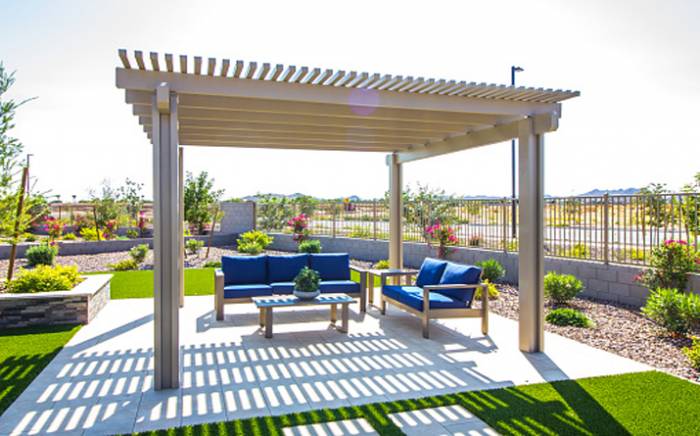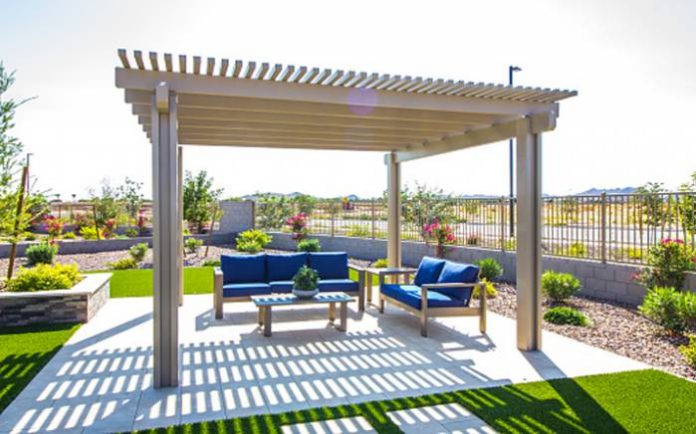Over recent years, the yard structure that is known as a pergola has boomed in popularity as more and more people throughout the United States of America embrace the indoor / outdoor living practice. Although they have become commonplace fairly recently, pergolas have actually been around for many thousands of years, with them being first used back in Ancient Egypt.
Because of their relative obscurity until more recent times, pergolas often get confused with other similar structures that can be found in the backyards of American homeowners, such as pavilions, trellises, arbors, gazebos etc.

Pergola are now common structures within very many yards throughout the country and are a good compliment to any outdoor living space. This is because they create a real focal point and act as a hub for guests to congregate around when you host any sort of party or social event. Pergolas also act as something of a transitional space that provides both privacy and shade in equal measures, whilst also at the same time still feeling open because you are still able to see the sky whilst sitting underneath.
Pergolas Versus Other Garden Structures
An all weather outdoor pergola is very similar in many respects to a pavilion – the only difference being that it does not have a solid roof. Pergolas with lattice type or open roofs provide you with the perfect mix between being well shaded on a sunny day and a feeling of openness. Additionally, a lattice roof is perfect for either hanging or growing plants on, thus giving your pergola a much more natural feel.
Some people out there confuse pergolas with trellises or arbors, which is an easy mistake to make given the fact that these structures are all very similar, but just have different functions. For instance, arbors are typically smaller in size and are more tunne shaped in order to create something of a passageway that climbing plants can grow up. The walls of these tunnels are trellises. It is arbors that are used as the entryway into a yard or any other type of outdoor space.
The purpose of a trellis is to provide guidance and support to those plants that climb via the lattice work on it. Trellis can be incorporated into both pergolas and arbors, as well as being used on their own as a yard structure.
Different Types of Pergolas
The vast majority of pergolas that you see in people’s yards are either vinyl or wood. That being said, they do also come in various other materials also, such as fiberglass and metal. The decision on which material to go for comes down to your own personal preference on which style would look best in your yard, as well as how much you are willing to spend on a pergola.
Vinyl Pergolas
Providing a clean, elegant, and classy look, vinyl pergolas are very popular with many homeowners throughout the United States of America because of how maintenance free they are. They only need to be washed down every one to three years in order to remove any grass, mold, or dirt that may be on it. These things are particularly problematic in those parts of the country that experience a more humid climate. However, if correctly maintained, vinyl pergolas can last for almost a lifetime.
That being said, over time vinyl can become somewhat brittle, causing it to gouge or crack when put under pressure. For this reason, it is important that it is made out of the very best type of vinyl material. When it comes to color, there is not much to choose from with vinyl pergolas as they predominantly come in white or variations of. They are very affordable though, which makes them a good choice for those people who are on a tight budget.
Wood Pergolas
These are very common and provide a much more rustic look. Because wood is in such great abundance throughout the country, this type of pergola is relatively cheap. That being said, redwood and cedar can be expensive. The material can be easily painted or stained to any color that you want so that it fits in with the style of your yard and the rest of your property. Wood pergolas are better suited to those parts of the country that are drier. In order to increase the lifespan of these types of pergolas, some regular maintenance is required.
Fiberglass Pergolas
Regardless of what weather conditions a fiberglass pergola is exposed to, it will not pit, corrode, or rust, it will require very little in the way of maintenance, and best of all, it will last a very long time. Fiberglass also is very good at holding paint and does not absorb any moisture at all – this is the main thing that causes paint to peel and crack. Because the material has a really good weight to strength ratio, it can be used to cover large distances without it sagging at all. However, because of these many benefits, fiberglass pergolas are very expensive.
Metal Pergolas
There are many different types of metals that can be used to build a pergola with, such as steel and aluminium. The good thing about using aluminium is that it is really lightweight and will never ever rust, regardless of what weather conditions it is exposed to. This makes it an ideal material to use when building pergola in a part of the country that experiences a lot of rain or on a property that is close to the ocean.
However, because an aluminum structure is so light, it is important that it is anchored to the ground in order to prevent it from being blown over during heavy winds. Aluminum can also be powder coated, which allows you to add a bit of colour to your yard. Steel is much more heavy duty and longer lasting, as it is able to withstand harsh weather conditions. Using the material to cover a wide roof space does not require the need for additional supports.







































